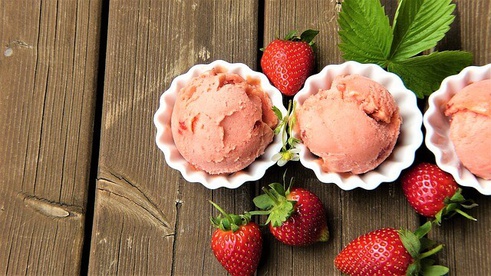In the past, ice cream was a "homemade" treat, made from whole eggs, milk, cream and sugar. It was only served on special occasions and holidays. Currently, in our society in loss of values and references, it is considered as a common food and widely distributed in supermarkets.
The basic products used to make our grandmothers' ice cream have changed, from an icy mixture of cream, milk, sugar and natural flavors, to many other ingredients and chemical stabilizers with clever names. In addition, it appears that the current law does not yet require manufacturers to list all the additives they use. Therefore, this "delicacy" can, depending on the industrial manufacturing method, turn out to be a real poison.
Indeed, most industrial ice creams often contain many additives and some ingredients sometimes quite surprising. These additives, although authorized, are not without undesirable effects or bad for health. See for yourself.
Tartrazine (E102) is a yellow food coloring allowed in France, but banned in the United States and Norway. This synthetic product in the form of powder or granules light orange, yellow in solution in water.
It presents risks of allergy in people intolerant to salicylates (aspirin, berries, fruits) and trigger asthma attacks in people who are prone to it. In association with benzoates (E210-E215), tartrazine would be involved in a large percentage of cases of hyperactivity syndrome in children.

The additive E171, titanium dioxide or titanium dioxide is authorized in France. This food coloring, white This additive is mineral results from the combination of two oxygen atoms with titanium. Its safety is controversial.
E405 is an emulsifier, thickener and stabilizer. It is propylene glycol alginate which is authorized in France under conditions, that is to say by limiting the maximum quantities authorized in a food and the foods to which it can be added.
The carrageenan, E407, is authorized in France, but is prohibited for example in Brazil where it is considered as carcinogenic.
This additive belongs to the family of emulsifiers and is used as a thickener, elifier and stabilizer in many foods such as ice cream, sauces, yoghurts and other dairy desserts. As with many additives, it is not the original substance of the additive that is dangerous, but the manufacturing or extraction process of the additive in question that makes it toxic.
This is the case for carrageenan, this substance is certainly a gelling agent of natural origin derived from red algae, however these are heated at high temperature and treated with certain acids. This additive with laxative effects could cause allergies, indigestion, weaken the immune system and in high doses, decrease the assimilation of essential minerals. (Food additives danger, by Corinne Gouget www.santeendanger.net)
According to Dr. Russel Blaylock, a leading expert on food additives, these carrageenans are known by researchers to significantly increase free radical production and produce an inflammatory reaction. If they are associated with glutamate, this reaction can last over time. (Health and nutrition secrets, Dr Russel L Blaylock)

And finally, let's not forget the famous aspartame which is currently all the rage in our supermarkets thanks to the great vogue of "light" products.
Aspartame, disguised on some labels as E951 is authorized in France. It belongs to the family of sweeteners, it is an additive of pure synthesis.
The acceptable daily intake (ADI) retained by the World Health Organization is 40 mg/kg/day (or 2.8 g for a 70 kg adult) since 1975.
During digestion, aspartame loses its hydroxymethyl group (methanol, a toxic compound), then breaks down into its two basic amino acids, aspartic acid and phenylalanine.
Methanol at 200-500mg/kg body weight is toxic and may cause vision and central nervous system problems. Methanol is dangerous for humans in too high concentrations. However, as soon as it is formed, it is immediately rejected by the body through respiration.
Phenylalanine is an amino acid found in proteins however it is involved in phenylketonuria (PKU), a rare genetic disease (1/15,000 births) causing severe mental retardation in affected children. Aspartic acid is an amino acid, non-toxic for the body.
Risks: Should not be consumed by people with phenylketonuria. Suspected of damaging the brain.
And in some very low-end products the following additives have even been observed:
- Ethylene Glycol: This low-grade chemical is used as an emulsifying agent instead of eggs. It is also an ingredient in paint solvents and car antifreeze.
- Piperonal: This chemical, replacing vanilla flavoring, is also used to kill lice.
- C 17 Aldehyde: Used to mimic cherry flavor, it is also a flammable liquid found in aniline-based dyes, plastics and rubbers.
- Ethyl acetate: Used as a pineapple flavoring, it is also a leather cleaner. Its vapors have been shown to cause chronic organ damage.
- Butyl aldehyde: Used in maple-flavored ice cream, it is also an ingredient in rubber cement.
- Acrylic acetate: Used as it is for banana ice cream, it is also a paint solvent.
- Benzyl acetate: Used as a flavoring for strawberry flavor, it is also a solvent for nitrate



